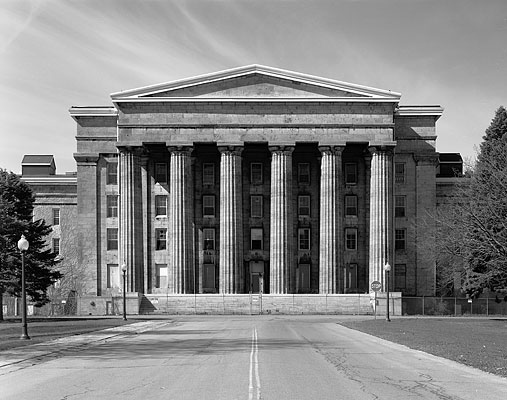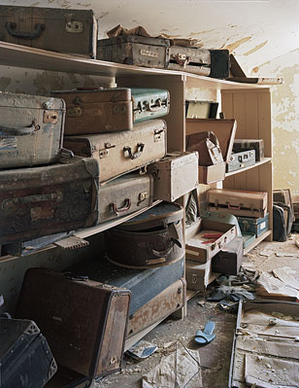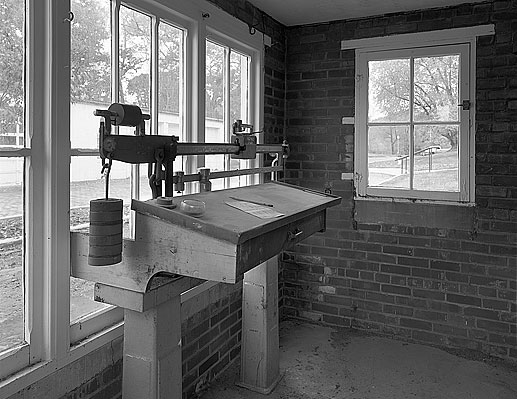This is an archive of the ArtCat Zine, 2007-2009. Please visit our new project, IDIOM.
On Christopher Payne: Nostalgia and the Asylum

Asylum: Inside the Closed World of State Mental Hospitals
The Urban Center, New York NY
Friday, July 10, 2009
Straitjackets, cavernous hallways with peeling paint, a title cast in a well-worn sensationalistic mold: the marketing for Chris Payne's Friday presentation at the Architectural League of New York set up a familiar sort of expectation for me. I knew what I would hear. The photographer, fresh from a day trip to one of the more convenient asylum-hulks in the area, would play up the Gothic-horror angle, show lurid closeups of bloodstained old medical equipment, insinuate that the place was haunted, then hawk his book to the audience. I, too, showed up, ready to do my part — scribble “Foucault” in my notebook, quote some old situationist to the effect that “the newest school buildings are indistinguishable from the newest prisons or the newest industrial complexes,” and so on.

The reality was a pleasant surprise. Payne is no idle urban explorer; his project involves the careful photographic documentation of state mental hospitals all over the United States. He has a genuine affection for these old spaces, not because of their creepy ambiance, but because they are the remnants of self-sufficient little communities that once enclosed everything from dairy farms to power stations. For Payne, they represent an echo of an America that once was — a place where things were still made, where homes were more than faceless condominiums. (He is an architect by training, so it is unsurprising that the real horror for him is the asylums' gradual destruction at the hands of condo developers.) His photographs are thus suffused with a peculiarly poignant kind of nostalgia; in many cases, the buildings they depict have already been demolished.
The state mental hospitals, he explains, were built between the mid-nineteenth and early twentieth centuries, before psychotropic drugs and scientific psychiatry. (In fact, the Association of Medical Superintendents of American Institutions for the Insane was the precursor to the APA). In the absence of any reliable neurological treatment, the patients were offered complete isolation, natural surroundings and plenty of manual labor. At its height, the system housed over half a million people, the hospitals' farms and shops contributing to local economies throughout the country. In the postwar period, however, inmate labor was banned and a variety of new therapies made the asylums obsolete. Some still function; others are used as prisons or housing complexes, or simply stand empty.
It would be easy to characterize these institutions along Foucauldian lines, as incomplete anticipations of today's integrated medical-disciplinary complex. But they were more than that: they belonged to their century. In itself, the idea of a therapeutic retreat offering manly work and structured treatment in a secluded natural setting owes much to Rousseau's educational program (as outlined in Émile), but here it was filtered through the characteristic scientism of the nineteenth century. They are not, indeed, very far from the idealized phalansteries of the utopian socialist Fourier.

In fact, their close counterparts were the Transcendentalist intentional communities that sprung up throughout America in the middle of the century. Like the Transcendentalists, the inmates of mental hospitals left their private possessions at the door (rooms full of still-packed suitcases remain in some of the wards). They lived and died in common, surrounded by nature. In their own way, the asylums were utopias too, and the “labor cure” a product of a specific kind of utopianism — one which shows through in Hegel, Thoreau and Tolstoy, not to mention the concentration camps of a later age. By shaping nature, imposing his stamp on it, the inmate could rejoin the community of men.
Chris Payne's photographs are nostalgic because he is a preservationist and because they record vanishing buildings. Even more fundamentally, however, they are nostalgic because their subjects had already disappeared. In one sense, the deathblow had been dealt by the ban on inmate labor, which enforced an atmosphere of constant idleness. (A few photographs depict stacks and stacks of chairs. “They sat around a lot,” Payne says.) This made them irrelevant to the economic life of their surrounding communities, parasitic rather than self-sufficient. But in another sense, the purpose behind the institutions had already become obscure with the passing of the nineteenth century. It is because all the utopian content was gone that these buildings could rejoin “the newest prisons and the newest industrial complexes,” spaces drained of everything but their disciplinary function. What distinguishes Payne from his horror-fetishizing counterparts is that he sees the motion of history at work in the asylums — not simply history’s absence.
ZINE
HOME
TIPS / COMMENTS
CATEGORIES
CONTRIBUTORS
- Greg Afinogenov
- B. Blagojevic
- Adda Birnir
- Susannah Edelbaum
- Julie Fishkin
- Paddy Johnson
- Jessica Loudis
- Christopher Reiger
- Andrew Robinson
- Peter J. Russo
- Blythe Sheldon
- S.C.Squibb
- Hrag Vartanian
